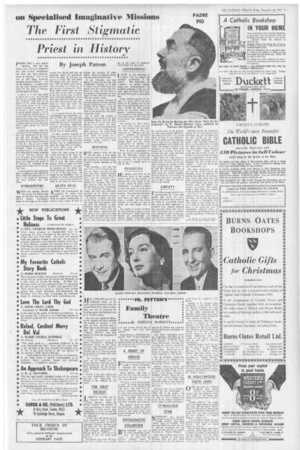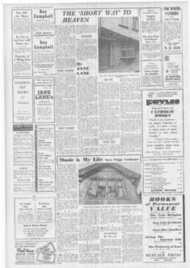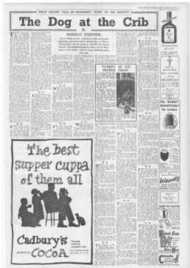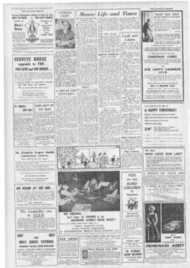Page 9, 6th December 1957
Page 9

Report an error
Noticed an error on this page?If you've noticed an error in this article please click here to report it.
Tags
Share
Related articles
25 Years
Padre Pio Is Ill Again
Myth And Miracles Of Padre Pio
Padre Pio: Holy See Takes Over
Padre Pio Holes In Hands And Feet
The First Stigmatic Priest in History
By Joseph Patron
PADRE PIO is now almost seventy. For the last thirty years, the once shepherd boy and austere seminarian has been the first stigmatic priest in history*. Yet at the end of this long, humanly speaking unconsoled and — but for the stigmata — uninteresting life, his most striking characteristics are his sense of humour and his apparent youth.
It seems as if time had ceased to affect him at all ; as if he had attained to a second, more steadfast, boyhood. And close to the surface of his words and gestures there seems always to lie close a certain bubbling joy. One sees it in the way he says " permesso" as he moves rapidly through a crowd, in his frequent amused grunts in conversation and even during confession, and in the many anecdotes reported about him. Confronted by a wailing woman. I have seen him, with a smile, imitate her wail to perfection.
At first one may be a little disconcerted by the mixture of gruffness and tenderness in his manner. But after dogging his steps for some days one begins to feel something of the single-mindedness of this life. All of one's cloudy preconceptions of sanctity are soon diapelled. Truth is simple and uncornpromistng. It is what cornmon sense had all along suspected it to ke. Whoever identified the man of prayer. or the mystic, with obscurantism ? Here everything is sharp and naked as the sword of St. Michael the Archangel in the picture in the little church over the high altar.
In the world it is the spectaculaz that is sought for and advertised. Here, where the spectacular is, in fact, to be found in abundance, one feels satisfied with little things.
WORSHIPPERS
WHEN the weather permits him to say his Mass in the open, at half-past one and even before, solitary worshippers begin to converge on the piazza
outside the church and take up positions round the balustrade before the altar. By 4.30 a.m. the piazza is usually full with about 500 people and any number ot cars. Then the lights in the arcade where the altar is to begin go on and the altar is prepared for Mass. Three thick rubber mats are laid down side by side below a carpet at the foot of the altar. A microphone half-hides behind the central altar card. The nuns from the hospital and visiting priests take their stand on either side within the balustrade. and they may later receive Holy Communion from Padre Pio.
It is a quarter to five. He enters imperceptibly and immediately begins his Mass. His voice,espeaking in a low. rather mournful tone. comes clearly over the microphone There is something undefinably personal and touching about the timbre of it. It is both tender and full of mature understanding.
As Mass proceeds towards the Canon, day dawns over the slopes of Monte Gargano and the poor people who live in San Giovanni Rotondo and its neighbourhood ; while the large town of Foggia— an hour's drive away--and the world beyond it still sleep.
There are long pauses at the critical moments of the Mass. Except during these, he shifts the weight of his body restlessly from foot to foot. He wears special sandals. When he kneels one fears he will never manage to rise again. At moments his face seems contorted with pain. And all the time it is as if he bore some vast weight on his shoulders, while tie conducts an intense and sustained dialogue, a prolongued petition, at times OR the verge of desperation.
QUITE REAL
AFTER the consecration he examines the paten most carefully Al times during the Mass he pauses meditatively to remove some speck of dust or change the position of some object. Here everything is lowly and personal and quite real.
At the " Dornine. non sum dignus" he beats his left side with considerable violence. It is said he loses a cup of blood every day, mostly from the wound in the side When he turns with the Host at the people's Communion his face reflects vividly what our own poor faith can scarcely reach.
At the last Gospel, oblivious of the direct glances of those standing directly before him, he recites the prologue of St. John—as he did the Credo—in a way that brings home to one powerfully the reality behind the words.
As he turns one catches a glimpse of the inside of his now unmittened hands, with the dark red patches of blood that reach almost to the fingers The latter arc always a little curved and held together, as if they could not he easily separated. He usually holds his hands above the level of his waist. When he kneels on a cushion for the final prayers, one suddenly recalls again those wounds in the feet.
BLESSING
SOME minutes after he has left the altar, a door opens on the left and he appears, fresh and smiling in his brown habit, to give a quick blessing to the people.
One morning a girl who had been sitting on the-balustrade beside roe dashed forward at this point and, after kissing his hand. returned to her father. Minutes later I saw her surrounded by a crowd of people. Her father claimed his daughter had never been able to walk, far less run, like that before. Later I heard that in the preceding fortnight two women who had been previously examined at the Rome Cancer Hospital had been cured of cancer..
On another occasion, also during the Mass, we heard something very much like mad laughter corning from the distance, a semimelodious shriek, rising and falling. Padre Pio turned from the altar and asked a person to find out what it was. Soon the noise ceased, and we heard later it had been some mad girl in the country nearby. One could not help think mg of the cases of possession which Padre Pio has cured.
CONFESSIONS
LATER in the morning, at about 7.30, he begins the women's confessions in the church. The half-light, the " mutter " of several Masses being said simultaneously, the palpable tenseness in the air, the clear sight of Padre Pies face. all make this scene a memorable one.
Under shifting patches of sunlight, the upper half of his body visible to all, leaning now to one side of the confessional, now to the other, holding the little wooden shutter in his hand, Padre Pio glances unselfconsclously from time to time at the tightly-packed crowd that stares at him with such impudent but understandable curiosity,
One notices the slight stature, the short white beard, the lock over the forehead on the otherwise shorn head, the dark eyes, expressive of suffering and suggestive, somehow, of personality not centred in itself, the whole rather like some shrewd, earthy peasant thrust into the double straight-jacket of sanctity a n d fame. The beard and moustache give his face a certain anonymity.
While he hears confessions he does not appear to be concentrating. He frequently strokes his habit with one hand or turns aside for a moment. The main impression is one of tranquil desire to lose no time.
PENITENTS
HE spends some five or six hours daily in the confessional, either in the church or between the white sheets in the sacristy where he hears men's confessions. In order to confess to him one needs to write one's name in a book and be given a number. Men usually have about a week to wait, and women— since there are more of them— about a month ; but this rather depends on the time of year. In winter one need hardly wait at all.
The sacristy is usually crowded. the men forming a large L round the confessional. Padre Pio's confessions are unpredictable and uniquie, though outwardly there may be nothing to show this but
the copious tears of the penitent. He treats each penitent differently. and often gives him a tap on the cheek by way of encouragement He often solves intricate problems with a most human, though illumined prudence, and without hesitation. The briefest of visits to the monastery of Santa Maria dellc Grazie—as it is called--is sure to provide one with many first-hand accounts of such occasions.
Apart from the mass and confessions one may see Padre Pio at certain fixed moments of the day when he gives the people a blessing, usually from the window of his cell. But—needless to say—in addition to this invariable timetable, there are various loopholes through which the importunate and the needy may enter, especially if they be men. These one may best find out for oneself.
LIBERTY
TN an these peregrinations he is accompanied by a friar who guards him from the overzea ous, from those who snatch at his habit or practically knock him over in their eagerness to establish firm contact between him and some object they wish to bless. Much extra pain is undoubtedly inflicted on him in this way. especially by those who handle and kiss his wounded hands as if they were inanimate objects. Standing outside the monastery, waiting for the blue bus to carry one away. one can see above one the vast outline of the Casa Sollievo della Sofferenza, built mostly with American donations. Below, on the other side, is a large new hotel called after the monastery. Many villas—some unfinished —and " rosary" shops cluster round this last stretch of road. In between and beyond the buildings, on the mountainside. sturdy young cypresses have been planted by the thousand. But this is still hermit country . .. rocks and shrubs and cold. moistureless air.
The main impression of my visit wers that of the creative and liberating power of suffering, especially the suffering of the innocentThose who come here are quick toeunderstand that it is with his actual blood that Padre Pio ransoms souls and obtains the answers to prayers. One understands a little better the meaning of the sacrifice of Calvary.
The fruit of this suffering is the Liberty of the spirit. When one is near him, one has the impression that nothing is impossible, that there exists a new world for us yet to discover—the world of the spirit — in which the soul is wonderfully released from its weaknesses and limitations and enjoys the true liberty of the sons of God.
• Francis of Assisi was merely a deacon and was never ordained priest.
blog comments powered by Disqus















